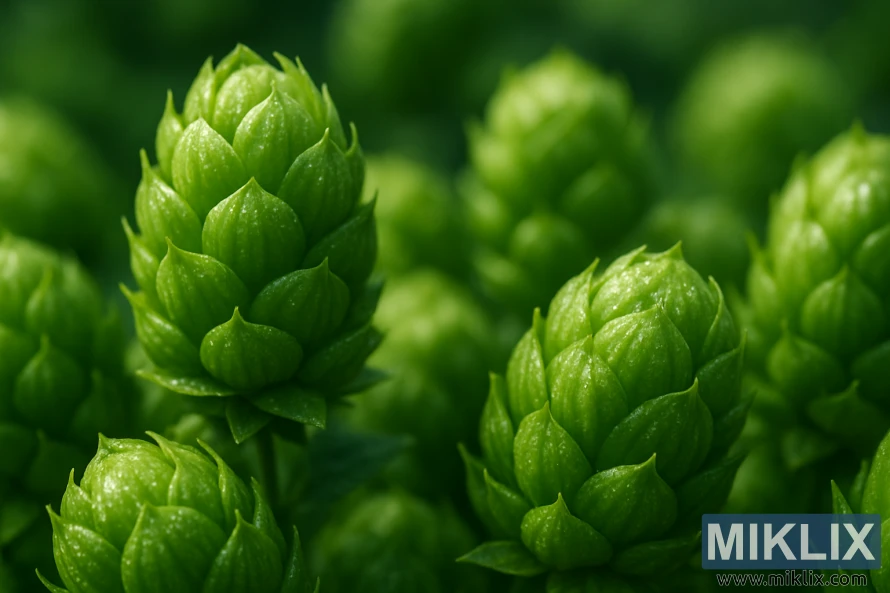Image: Millennium Hop Cones Close-Up
Published: August 17, 2025 at 6:44:35 PM UTC
Last updated: September 26, 2025 at 8:56:12 PM UTC
Detailed close-up of Millennium hops with verdant cones and lupulin glands, highlighting their bitterness and aroma essential to the brewing process.
The photograph draws the viewer into an intimate encounter with Millennium hops, capturing their intricate form and vibrant vitality in remarkable detail. The cones, clustered in the foreground, appear tightly packed and verdant, their rich green bracts overlapping in symmetrical layers that spiral upward toward pointed tips. Each cone feels alive with energy, a miniature architectural wonder shaped by nature’s precision. Their forms are plump and full, heavy with promise, and their outer surfaces glisten faintly under the touch of soft, natural light filtering from above. This gentle illumination reveals delicate textures, fine ridges along each bract, and subtle variations in hue that range from bright lime green to deeper, more shaded tones.
The photograph’s shallow depth of field ensures that the viewer’s attention remains centered on these captivating details. The cones in focus seem almost tangible, as though one could reach out and pluck them from the frame, feeling the papery resilience of the bracts between the fingers. Tiny flecks of golden lupulin, though mostly hidden inside, are suggested by the faint sheen that shimmers across the surface, hinting at the resinous wealth contained within. These lupulin glands are the true essence of hops, housing the concentrated alpha acids and aromatic oils that define their character. For Millennium hops, this translates into a powerful bittering potential balanced by unique layers of flavor—earthy, herbal, and subtly spicy, with an undercurrent of resin and fruit. Even in the stillness of the image, the imagination can conjure their aroma, sharp yet complex, and anticipate the transformative role they will play once introduced to the boil.
Beyond the sharply focused cones, the background softens into a lush blur of green. This bokeh effect suggests the presence of a thriving hop yard, rows of bines stretching skyward, though here reduced to atmospheric context. The contrast between the precise foreground and the softened expanse beyond emphasizes the individuality of each cone while simultaneously connecting it to the abundance of the field. It is a reminder that while every cone carries unique details, each belongs to a larger ecosystem of growth, cultivation, and harvest.
The natural lighting enhances the mood, casting a warm, golden glow over the scene without harshness. It evokes the late afternoon sun of a midsummer’s day, when hops reach their peak vitality. This illumination not only enhances color and form but also conveys a sense of ripeness and readiness, as though these cones are on the cusp of being harvested and ushered into their next phase of existence. The mood is one of quiet anticipation, the moment before transformation, when the hops are still bound to their vines yet already carry within them the future flavors of beer.
Altogether, the photograph becomes more than a botanical close-up. It is a meditation on potential, on the journey from field to kettle, from raw cone to crafted pint. The Millennium hops shown here embody both the agricultural labor that nurtured them and the artistry of the brewer who will unlock their flavors. They are symbols of transition, caught in the perfect balance between nature and craft, between growth and creation. By focusing so closely on their form, the image elevates these humble cones into icons of brewing, celebrating their complexity and the promise they hold within their resinous depths.
The image is related to: Hops in Beer Brewing: Millennium

